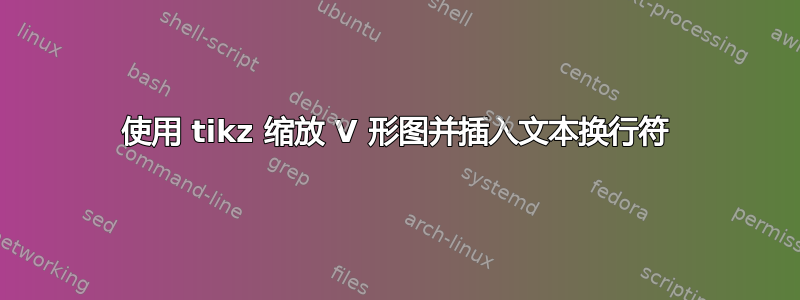
我正在使用创建 V 形图tikz,但遇到两个问题:
它太长了,超出了我的文档范围
我认为改变宽度(线宽长)也需要为较长的文本添加换行符,否则文本将超出 V 形范围(这只是我的猜测)
这是我的例子
\begin{figure}[h]
\centering
\begin{tikzpicture}
\tikzset{
arrow/.style={
draw,
minimum height=2cm,
shape=signal,
signal from=west,
signal to=east,
signal pointer angle=110,
}
}
\begin{scope}[start chain=transition going right,node distance=0, draw=blueaccent, distance=\linewidth]
\node[arrow,on chain] {Auswahl};
\node[arrow,on chain] {Exploration};
\node[arrow,on chain] {Stichprobenziehung};
\node[arrow,on chain] {Vorverarbeitung};
\node[arrow,on chain] {Transformation};
\node[arrow,on chain] {Wissensgewinnnung};
\end{scope}
\end{tikzpicture}
\caption{Data Mining Prozess}
\label{fig:DataMiningProzess}
\end{figure}
distance=\linewidth 似乎没有任何效果,并且width不是范围认可的选项。我也查看了这两个问题/答案,但它们处理的是节点本身,而不是 V 形(如果我没记错的话)。
- 编辑
我从这个答案中获得了 V 形代码:使用 Tikz 绘制 V 形图的最佳方法
新风:
\documentclass[fontsize=12pt,a4paper,oneside,
listof=totoc, % Tabellen- und Abbildungsverzeichnis ins Inhaltsverzeichnis
bibliography=totoc, % Literaturverzeichnis ins Inhaltsverzeichnis aufnehmen
titlepage, % Titlepage-Umgebung statt \maketitle
headsepline, % horizontale Linie unter Kolumnentitel
%abstracton, % Überschrift beim Abstract einschalten, Abstract muss dazu in {abstract}-Umgebung stehen
DIV12, % auskommentieren, um den Seitenspiegel zu vergrößern
BCOR=0mm, % Bindekorrektur, die den Seitenspiegel um 6mm nach rechts verschiebt. geometry package überschreibt diesen Wert
]{scrreprt}
\usepackage[pdftex,dvipsnames]{xcolor} % einfache Verwendung von Farben in nahezu allen Farbmodellen
\usepackage{pgfplots} % Zum erstellen von mathematischen Diagrammen, wie Balken, Flächen usw.
\usetikzlibrary{chains,positioning,shapes.symbols}
\definecolor{blueaccent}{RGB}{0,150,214}
\usepackage[a4paper, left=2.5cm, right=3cm, top=2.5cm, bottom=2.5cm, bindingoffset=6mm]{geometry}
\begin{document}
\begin{figure}[h]
\centering
\begin{tikzpicture}
\tikzset{
arrow/.style={
draw,
minimum height=2cm,
shape=signal,
signal from=west,
signal to=east,
signal pointer angle=110,
}
}
\begin{scope}[start chain=transition going right,node distance=0, draw=blueaccent, distance=\linewidth]
\node[arrow,on chain] {Auswahl};
\node[arrow,on chain] {Exploration};
\node[arrow,on chain] {Stichprobenziehung};
\node[arrow,on chain] {Vorverarbeitung};
\node[arrow,on chain] {Transformation};
\node[arrow,on chain] {Wissensgewinnnung};
\end{scope}
\end{tikzpicture}
\caption{Data Mining Prozess}
\label{fig:DataMiningProzess}
\end{figure}
\end{document}
答案1
我会使用单个 TikZpictures 来实现这一点。然后 TeX 可以自动分解它们。
\hspace只要下一个条目不是一行中的第一个条目,宏就会用来将其拉近。
样式tight prozess使用存储在中的值minimum height来计算水平空间,该空间以负数插入到节点的末尾,以便右侧部分更靠近文本。该.75因子只是目测的,因此看起来足够美观。我们也可以使用类似的数学来计算将条目拉近所需的水平空间,但测量 viacalc要容易得多。
代码
\documentclass[fontsize=12pt,a4paper,oneside,DIV12,BCOR=0mm]{scrreprt}
\usepackage[pdftex,dvipsnames]{xcolor}
\usepackage{tikz}
\usetikzlibrary{shapes.symbols,calc}
\definecolor{blueaccent}{RGB}{0,150,214}
\usepackage[a4paper, left=2.5cm, right=3cm, top=2.5cm, bottom=2.5cm, bindingoffset=6mm, showframe]{geometry}
\newcommand*\prozess[2][]{%
\foreach\proz[count=\prozI] in {#2}{%
\ifnum\prozI>1\relax\hspace{-\throwaway}\fi
\tikz[prozess picture,#1]\node[anchor=base, prozess/.try]{\proz};}}
\tikzset{
prozess/.style={
draw=blueaccent, minimum height=2cm, shape=signal,
signal from=west, signal to=east, signal pointer angle=110,
text depth=+.3\baselineskip, text height=+.7\baselineskip},
prozess picture/.append style={
baseline, nodes={append after command={
let \p@=($(\tikzlastnode.east)-(\tikzlastnode.north east)$) in
\pgfextra{\xdef\throwaway{\x@}}}}},
tight prozess/.style={
prozess/.append style={
execute at end node=\pgfmathparse{.75*
(\pgfkeysvalueof{/pgf/minimum height})/2
/tan((\pgfkeysvalueof{/pgf/signal pointer angle})/2)
}\hspace{-\pgfmathresult pt}}}}
\begin{document}
\begin{figure}[h]
\raggedright
\prozess{Auswahl, Exploration, Stichprobenziehung, Vorverarbeitung, Transformation, Wissensgewinnung}
\caption{Data-Mining-Prozess}
\end{figure}
\begin{figure}[h]
\raggedright
\prozess[tight prozess]{Auswahl, Exploration, Stichprobenziehung, Vorverarbeitung, Transformation, Wissensgewinnung}
\caption{Data-Mining-Prozess}
\end{figure}
\begin{figure}[h]
\centering
\prozess[tight prozess]{Auswahl, Exploration, Stichprobenziehung, Vorverarbeitung, Transformation, Wissensgewinnung}
\caption{Data-Mining-Prozess}
\end{figure}
\end{document}



